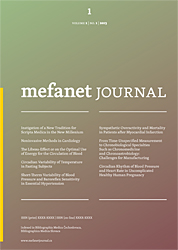
MEFANET Journal 2015; 3(1): 4
EDITORIAL MATERIAL
Preface
Daniel Schwarz
Institute of Biostatistics and Analyses, Faculty of Medicine at Masaryk University, Czech Republic
schwarz@iba.muni.cz
With a great pleasure we present the first 2015 issue of the MEFANET Journal (MJ). MJ is dedicated to provide readers around the world with high quality peer-reviewed articles on a wide variety of topics related to applications of computer science and technology-enhanced learning in medical education. Its mission is to become the premier vehicle for disseminating information about the MEdical FAculties NETwork (www.mefanet.cz), which covers all Czech and Slovak medical faculties as well as schools and faculties of health care sciences.
This first issue of the third volume comprises two original articles, two review articles and one detailed editorial report on the last MEFANET 2014conference. The presented articles can be categorized into the following groups:
- information science and evidence-based medicine
- modelling and simulation
The paper by Barrick et al. reviews the current state of big data in pharma. The topic is very interesting and sensitive when it comes to handling data concerning patients – and the manuscript brings valuable information into light. Volšička & Blaha exemplify five different methods for performing full-text search in medical records and they introduce Apache Solr platform as a search engine which is robust enough to handle various pitfalls hidden in the Czech language. Tučková et al. share experience with PIRD method (P = population, problem, patient; I – index test; R – reference test; D – diagnosis of interest) and demonstrates an example of evidence synthesis in diabetes mellitus diagnostic tests for children. I believe that the article will be noteworthy especially for readers with the interest in courses of the information literacy for medical students. The original article by Tachecí & Ryška brings a new view on the development and usage of virtual patients or cases. The authors present their approach to extending the number of available virtual cases with the use of a pseudo-random generator. They point out that the cases solved by students are subsequently also discussed within tutorial lessons – enabling students to get a feedback from their teacher and enriching the learning process with the debriefing experience. The final editorial material by Gregor et al. recalls the most important memories from the last 8th year of the MEFANET conference, which took place in Brno at the end of November 2014. The MEFANET conferences have always been providing a vibrant meeting place for delegates from medical and healthcare faculties, computer scientists as well as medical teachers and students from the Czech Republic, Slovakia and other countries. In 2015, the upcoming 9th year of the MEFANET conference (25–26 November 2015 – Brno, Czech Republic) will be focused on technology-enhanced learning and teaching in psychiatry, neurology and neuroscience.
I would like to extend my sincere appreciation to the editorial members and reviewers, without whom this issue would not come into existence. It is my hope that this fine collection of articles will be another valuable resource for medical education stakeholders and will stimulate further research into this exciting area of science. Readers are encouraged to submit both comments on these articles as well as their own relevant manuscripts.
August 2015

Daniel Schwarz
Editor-in-chief










